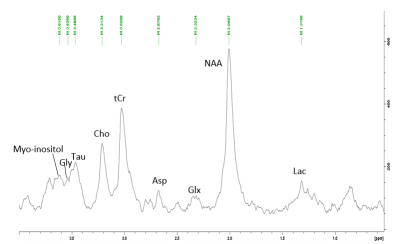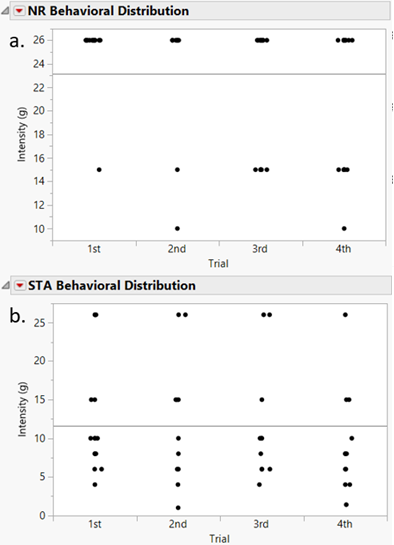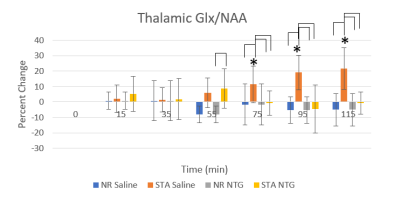2215
Metabolic Impact of Spontaneous Trigeminal Allodynia in Sprague-Dawley Rats: Implications for Migraine & other Neurological Disorders1National High Magnetic Field Laboratory, Florida State University, Tallahassee, FL, United States, 2Chemical & Biomedical Engineering, FAMU-FSU College of Engineering, Tallahassee, FL, United States, 3Molecular Neurology Program, Huntington Medical Research Institutes, Pasadena, CA, United States
Synopsis
Spontaneous Trigeminal Allodynia (STA) occurs within ~50% of male Sprague-Dawley rats, presents symptoms analogous to migraine and may be alleviated by migraine treatments. Relaxation-enhanced MRS implemented in the female rat thalamus at 21.1 T examined metabolic effects of STA using a nitroglycerin-injected model of migraine. It was found that STA generates glutamate/glutamine and limited lactate responses with even saline injection. However, the STA response is rendered negligible when given a conventional dose of 10-mg/kg nitroglycerin. Future spectroscopic examinations of neurological disorders, particularly those focused on excitotoxicity/neuroprotection, should account for this potential effect.
Introduction
Due to small genetic variances, ~50% of male Sprague-Dawley rats have been reported to develop spontaneous trigeminal allodynia (STA)1. Examined behaviorally, STA presents similarly to the mechanical allodynia and phono-sensitivity that accompany migraine; STA can be alleviated through triptans, a class of migraine treatment1. These similarities raise questions about the physiological impacts of STA and potential implications of an unevaluated factor within the commonly used Sprague-Dawley rat model, particularly for migraine research but extendable to other neurological models. To evaluate STA impacts, an established model for migraine based on nitroglycerin (NTG)-induced central sensitization was chosen for direct comparison. in vivo relaxation-enhanced MR spectroscopy (RE-MRS) was performed at 21.1 T within the female Sprague-Dawley rat thalamus. The thalamus was chosen due to its involvement in migraine attacks and previous metabolic response to NTG in the male rat, including significant changes in lactate (Lac), glutamate/glutamine (Glx) and taurine (Tau)2.Methods
The presence of STA was determined behaviorally through application of Von Frey filaments to the periorbital region. Filaments ranged from 0.008-26 g and were increased sequentially until an aversive withdrawal occurred in 2 of 3 or 3 of 5 applications. The trial was repeated four times, 1 h apart, on alternating sides of the head. Animals were separated into two behavioral groups, naturally resilient (NR) and experiencing STA, based on their mechanical sensitivity threshold. Prior to scanning, animals were anesthetized with 5% isoflurane in oxygen for surgery implantation of an intraperitoneal line to deliver nitroglycerin (NTG) in situ while in the magnet and after baseline scans were acquired. Post-surgery, rodents were maintained at 2-3% isoflurane in oxygen for the remainder of the scanning, then promptly sacrificed. Groups examined were NR animals dosed with saline (N=8), 2-mg/kg NTG (N=6) or 10-mg/kg NTG (N=6), with STA animals scanned at identical dosages (N=7, N=3, and N=4, respectively). Spectra (Figure 1) were acquired using a relaxation-enhanced, spectrally selective spin echo sequence localized to a 4x3x3-mm3 voxel via Localization by Adiabatic SElective Refocusing (LASER). The voxel was centered between thalamic lobes. With an effective TE=54 ms and TR=2.5 s, spectra were averaged eight times per repetition, with 32 repetitions performed. Peak selection was performed in Bruker Topspin 4. Scans repeated every 20 min out to 2 h post-injection.Spectral data was normalized to the NAA signal; ratios are presented as a percentage change from baseline values. Statistical analysis was performed in JMP Pro 15 (SAS, Inc). One-way ANOVA were used to establish significance along time and between NTG doses, with a post-hoc Student's t tests used to determine group differences, both with p<0.05.
Results & Discussion
The Von Frey examination denoted a clear difference between NR and STA animals. The spontaneous nature of STA is demonstrated in Figure 2. While STA animals may appear resilient during individual trials, their variance between trials is large, reaching mechanical sensitivity thresholds as low as 1.4 g. However, NR animals never drop below a threshold of 10 g and experience much less variance. Thalamic spectra show the clearest distinction between STA and NR groups with saline injection (Figure 3). At later times, saline STA Glx is significantly and progressively elevated from baseline levels, unlike saline NR. Notably, despite being a spontaneous condition, STA saline appears to display a Glx buildup over time, with larger variations at these later times. However, with NTG injection to induce central sensitization, NR and STA Glx signal changes are consistent (Figure 3), with only one time point showing a significant difference (t=55 min). NTG induction appears to overwhelm the spontaneous buildup of Glx, with possible increases in variance for the STA group at some time points.With respect to Lac, NR and STA cohorts are remarkably similar over time with NTG injection (Figure 4). As lactate would be increase with increased glycolysis to meet rising cellular energy demands, the Lac trends are consistent with previous examinations of the nitroglycerin model in male rats2, albeit occurring much at earlier times post-injection in females. The earlier Lac significance might be a sex-specific dose response, which is under evaluation. However, at the 2-mg/kg NTG dose, similar Lac trends are evident for NR and STA, though these fail to reach significance. At the highest NTG dose employed, the only potential difference between NR and STA cohorts may be the differences in variances at certain time points.
Conclusion
RE-MRS at 21.1 T was implemented to examine the metabolic impacts of STA and its impacts on a migraine analog. In the female Sprague-Dawley thalamus, STA induced buildup of Glx and late increases in Lac. Meanwhile, the impacts of STA with NTG triggering were negligible compared to NR animals aside from possible and occasional increases in variances with STA. Notably, the STA increase in Glx with saline is largely mitigated at both NTG doses. Regardless, the impact of STA should be considered in current and future investigations involving this animal model, particularly with respect to Glx-related substrates.Acknowledgements
This work was supported by the US NIH (R01-NS072497) and the US National High Magnetic Field Laboratory, which is supported by the National Science Foundation (DMR-1644779) and the State of Florida.References
1. Oshinsky, M. L. et al. Spontaneous trigeminal allodynia in rats: A model of primary headache. Headache 52, 1336–1349 (2012).
2. Abad, N. et al. Metabolic assessment of a migraine model using relaxation-enhanced 1H spectroscopy at ultrahigh field. Magn. Reson. Med. 79, 1266–1275 (2018).
Figures



